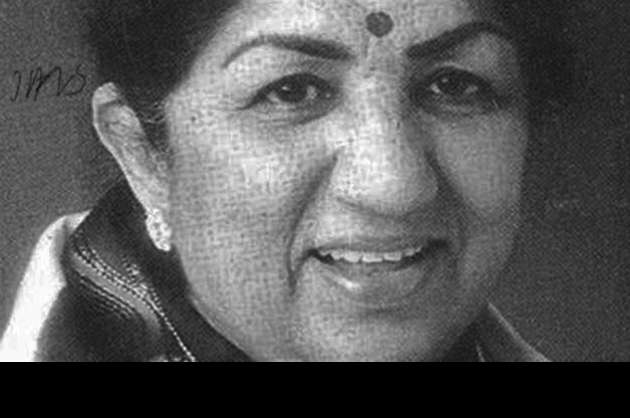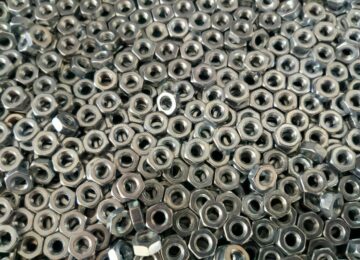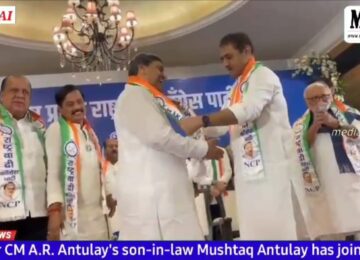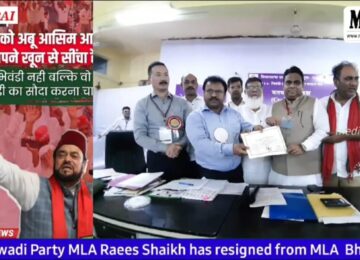Anupama Nair
Lata Mangeshkar is considered as one of the greatest singers in living history, no wonder she is called Swar Kokila, or nightingale of India and was awarded the highest civilian award Bharat Ratna. She left for her heavenly abode on 6th February this year, leaving a deep void, in Indian music that can never be filled. All lovers of music can never forget the impact of the news that greeted us on a Sunday. It has left an untold sadness in my heart. So, I am writing many articles about her, the facts I learnt in the course of my career.
Few of you might know that along with Veer Savarkar ji she also idolized one of the greatest male playback singer as well as actor K.L Saigal. Who can forget the song “jub dil he toot gaya” from the blockbuster film Shah Jehan released in 1946 starring Saigal himself? In those years or golden era of Hindi Music, it was necessary for an actor or actress to be a playback singer too. Saigal, Noor Jehan, Surendra, Suraiya are all great singers as well as actors and most of their films were block busters – Devdas, Anmol Ghadi, Mirza Sahiba, Rattan and many others.
Now, let me tell you about Saigal and I am sure, he needs no introduction to music lovers. Actor-singer Kundanlal Saigal, or K.L. Saigal, was born on April 11, 1904. Known for his unique voice, K. L. Saigal has sung over 185 songs throughout his career. He also established himself as one of the first true Bollywood superstars and worked on 36 films in three languages – 28 in Hindi, seven in Bengali, and one in Tamil. Some of his most popular and successful movies were Yahudi Ki Ladki, Bhukt Surdas, Tansen, Devdas, Street Singer, Lagan, among others.
Formal education in music was not easily available in those days, as we do now. However, he did whatever he could to learn music. Initially he got experience in acting in local Ramlila pandals. It is said that as a youth he used to sneak to the house of a local ‘tawaif’ so that he could hear her sing and later he would imitate what he heard. As a young man he tried several occupations. After he dropped out of school, he worked for a while as a railway timekeeper and as a typewriter salesman which gave him the opportunity to travel widely in India.
He started singing as an amateur. He used to sing in gatherings with friends and met many influential people. He had the luck to meet Meharchand Jain, who would become one of Saigal's early friend and supporter. In course of his travels, he also met B.N. Sircar the founder of New Theatres. It is said that it was Sircar, who persuaded Saigal to go to Calcutta. Saigal's life in Calcutta was full of music. Though, he briefly worked as a hotel manager, his sole interest was in music and he also participated in mehfils. He also recorded a number of songs written and arranged by Harishchandra Bali. These were released through Indian Gramophone Company. Little by little, his reputation as a singer increased. The film world at that time was in the midst of a revolution as the talkies was just introduced, and the producers were clamoring for actors who could sing like Saigal, Surendra, Punkaj Mullik, Noor Jehan and Suraiya.
You need to remember it was the time before the custom of ‘playback singing as we know in the golden era come into fashion. My dad who was a great fan of Noor Jehan and used to say “the actors and actresses sang their own songs, and musical ability was considered and important pre-requisite for a successful film career”.
Saigal's immensely famous music recordings proved to be his stepping-stone into acting in films. Saigal was later introduced to R.C. Boral, who signed Saigal to a contract with New Theatres. He was paid Rs. 200 a month to work to act in films. In those days Rs. 200 would have been worth crores. His first film was "Mohabbat Ke Ansoo" released in 1932. After that, he had roles in "Subah Ke Sitare", and "Zinda Laash”, both released in 1932. During this time, Saigal continued to make disks called Hindustan Records Company of which ‘Jhulana jhulao’ was popular. He continued to sing and act in a number of films, however, the film that was epoch-making was ‘Chandidas’ released in 1934. However, the film that shaped his career was ‘Devdas’ which was ironic as he was an alcoholic too and died due to heavy drinking like the character Devdas. After the phenomenal success of ‘Devdas’, there was no doubt that Saigal was a formidable entity in the film industry.
It was during this period that his personal life developed as well. In 1935 he married Asha Rani and had three children. There was a son named Madan Mohan (no connection to the director of the same name), and two daughters, Nina and Bina. It is said that in the years before his death, he was unable to sing or perform without first having a drink. This was affecting both his health as well as his work. He suffered from liver cirrhosis, and medical treatment was to no avail and he passed away on January 18th 1947 in Jalandhar, when he was only 42 years old.
Now let us come back to his relationship with Mangeshkar family, in the early 1930's, –the family of singers had their own idol, K.L. Saigal. His songs were very popular in the Mangeshkar household. In those days, they were only allowed to sing songs sung by Saigal. So, with no access to any other male singer's voice young Lata fell in love with him started to dream of getting married to Saigal. In an interview the Bharat Ratna said emotionally, "as far as I can remember, I always wanted to meet Saigal. As a child, I used to say that I will get married to him after I grow up, and that's when my father explained to me that when I'll be big enough to get married, Saigal saab will be too old enough to get married".
Unfortunately, Lataji was never able to meet up with her dream man. In her own words, she said, "I will always regret not to have met Saigal, the man of my dreams. But yes, with the help of his brother Mahendra Saigal, I did get a chance to meet his wife Ashaji and his children who gifted me Saigal saab's ring". Though she could not see him personally the ring would have meant much to her! Those were the days when music was the ‘milap of sur and taal’. Unfortunately, after the 1990s the film music lacked raag, alaap, tal, shruti aur sur, and you can imagine, without these no music would exist. Other than a few films like Parinita, Baji Rao Mastani and Padmavat, music ceased to exist. Hope “guzra hua zamana wapas aa jaye”!





























Kindly overlook the incidental needless gaps – in spacing between words, lines, and dislocation of text from the margins – that might have resulted in the process of sending this Mail to you. Since I happen to move quite back and forth in the process of preparing any text – deleting, adding, transposing, shifting, breaking, all right online – all the zigzagging and criss-crossing tends to show up as brokenness in the flow of text. So, you may have to bear with all this.
___________________________
OUR STORY
Our story starts here. The all-too-familiar and yet the not-so-familiar Maharaja of Kashi ( Varanasi, Benaras in Uttar Pradesh state ) had a substantial mass of land ( among his spread of other estates ) way back in the 1970s, and events took such a course that he ended up getting into an arrangement with a property developer of those days, one Sri Sarin, who took up the task of building a residential colony of flats ( which came to be known as Sheesh Mahal Colony ) in the Kamachha area of Varanasi, in a pattern of eight sets each, lined up on either side with a road-like space between them. The process of booking flats with a view to ownership started and gradually picked up. In the process, a senior gentleman made good on this opportunity and had one up-and-coming Flat booked in his name. This gentleman had been a Professor ( Yeleswarapu Siva Rama Krishna Sarma ) in the Botany Department of the Banaras Hindu University and was shortly about to retire from formal University services. So, his elder son ( whose details would follow later ) took the initiative in 1981 and completed the first few formalities related to this affair, after which it was left to this Professor to take over and carry on with the whole affair of construction, correspondence, financial transactions, and the other legalities and technicalities with the property developer, Sri Sarin, till the completion of the Flat ( B-7/12 ) in 1984. Meanwhile, the Professor had retired in 1982. And started residing in the Flat ( now his ) and continued so along with his wife till 1994, in which year he expired, aged 72 years. His wife had pre-deceased him in 1991, aged 63 years. During the two years after his retirement and prior to occupying his Flat, that is, 1982-84, he managed to carry on residing in the bungalow allotted to him in the Campus of the Banaras Hindu University.
During the normal course of such a colony of flats / housing society coming about, it is assumed that the booking of the flat in the name of the individual/s in question ( could be a case of joint / co-ownership, but for the sake of this narrative we confine our affair to the case of a single individual ) makes the individual the owner of that flat by virtue of the fact that it has gone through and would continue to go through all the due processes with regard to direct legal / official registration within the jurisdiction of the concerned municipal corporation / municipality. But, as it was destined to happen, in the context of this particular Colony of flats, the whole affair of finalizing the booking of the flat ; having the construction completed ; having in order all the financial transactions with the property developer ; and so on, got clinched in a manner that all the flats in this Colony of flats were deemed ‘registered’ without their direct linkage with any of the quarters dealing with property matters within the whole establishment of the municipal corporation / municipality of Varanasi. In the light of all this, it meant that, the individual ( now the deemed owner of his flat ) could afford to successfully exercise any of the options like renting, leasing, reconstructing, sub-letting, even selling, with respect to his flat, by simply notifying the property developer of his intent in writing ( even verbally / orally at times, along with the original receipts generated for the instalments paid during the process of construction ), without having to get in touch with any of the above referred quarters and going through the associated procedural formalities. So, it followed that, even during the period of residence of our Professor in Flat B-7/12 and prior to his demise in 1994, there were many changes taking place with respect to the other flats in the same Colony spanning various options mentioned above, which continued even long after his demise, and which even some of his erstwhile professor colleagues indulged in. However, since this ‘anomalous’ situation could not have continued for long, some owner-members of this Colony seemed to have mooted the proposal of eventually having all the flats in the Colony ‘directly’ registered, that is, in terms of their respective direct linkages with the property-related domains of the Varanasi municipal corporation / municipality, aiming thereby to do away with the role of the property developer, Sri Sarin. Gradually, this process got underway, and it became fairly obvious by the middle of the next decade ( 2000-2010 ) that indeed most ( save a couple of them, Flat B-7/12 being one of them ) of the flats in this Colony were successful in having themselves ‘registered’ in the formal legal / official / technical sense of the term as elucidated above.
Now, the details related to our Professor. He passed away without leaving behind any WILL ( written or even verbal / oral ) in the context of the Flat B-7/12. Among his progeny are two sons and one daughter ( now no more ). The elder son ( Yeleswarapu Pattabhiram, in his later mid-seventies ), basically a metallurgical engineer, served in different capacities in various organizations in the country before retiring in 2001. He has two daughters. The elder / first one, in her early fifties, is a major in English literature and teaches in educational institutions in Visakhapatnam. Her husband is a consultant professional. They have a son who is studying a professional course. Both her in-laws are no more. The younger / second daughter, in her later mid-forties, a qualified post-graduate in Microbiology, resides in Bangalore along with her husband, a marketing professional, two studying daughters, and both her old and infirm in-laws. Both these daughters of Sri Pattabhiram have been through his first wife ( married in 1968, pre-deceased him in 1976, aged 26 years ). Sri Pattabhiram has a son ( an automobile engineer in his mid-thirties, unmarried ) through his second wife ( married in 1983 and now in her early seventies ). At present, Sri Pattabhiram is severely incapacitated owing to various major multi-organ intertwined complications and looking forward to a peaceful end. ( Just to intervene – he passed away on 23 September 2020. ) His wife, both hypertensive and diabetic, is just about able to keep the affairs of the house going, having undergone a major heart-related surgery in 2011. His son is extremely tied down with his professional engagements. The three ( now two ) of these reside in Bangalore city.
The Professor’s younger son ( Yeleswarapu Jaya Ramakrishna, in his early mid-seventies ), basically an orthopaedic surgeon, served in different capacities in various organizations in the country before retiring in 2006. His wife ( also in her early mid-seventies ), basically a general physician, served in different capacities in various organizations along with him in the country before retiring around the same time in 2006. Married in 1981, they have a daughter ( nearing her forties, married ) associated with a library in some assistant capacity. Their son died in 2014 ( aged 29 years ) under tragic circumstances. Sri Jaya Ramakrishna keeps extremely indifferent health, is quite shakily mobile, and does not move out of station unless absolutely essential and that too with someone by his side. His wife is less shakily mobile and does not move out of station so frequently and that too with someone better by her side. The three of these reside in Visakhapatnam city.
The Professor’s only daughter ( Yeleswarapu Lalita, turned Lalita Kota post-marriage ), basically a semi-post-graduate in Botany, got married in 1967 to a research scientist and had a son in 1971. After a successful married life of many years, she devoted herself to humanitarian endeavours as also some art-related endeavours before passing away in 2002 ( aged 53 years ) as a fallout of long-standing massive multi-intertwined complications of a systemic nature. Her husband ( now 80 years of age ) has been engaged in professional and advisory capacities across a wide-spectrum of endeavours – scientific, literary, educational, humanitarian, institution-building. He is active enough but not that mobile as he would like to be. Their son ( in his early fifties, unmarried ), accomplished and qualified in various ways, is and has been engaged in a wide spectrum of endeavours having to do with writing, editing, language translating, teaching-learning, academics, and research, apart from other art-related concerns. These two reside in Hyderabad city.
Our Professor’s Flat has been on rent to one Sri Kavuri Kalyan Rao ( in his early sixties ) since 1995, courtesy the efforts of Sri Pattabhiram during his active days. Sri Kalyan Rao has been serving the National Egg Coordination Committee ( NECC ) in different capacities and has been residing in this Flat all through, with his wife, and two daughters who have grown older and do not stay with the couple on a regular basis, owing to their professional and educational commitments elsewhere in the country. The couple, since very long, have kept harping on their intent to go back to Vijayawada city ( Andhra Pradesh state ) at the earliest possible opportunity, but do not seem to have succeeded so far. Sri Kalyan Rao continues to be in service for now.
SOME VALUE BITS
The Flat B-7/12 remains for now in an extremely revolting condition and is not likely to show any signs of improvement in the near future insofar as congenial habitability is concerned. That stated, Sri Kalyan Rao ( along with his wife ) was finally made to vacate the Flat, which event took place during 2021. Matters regarding the payable monthly rent and clearance of other bills and taxes with respect to this Flat have remained virtually unknown to many, even within this close circle of stakeholders.
The original receipts generated for the instalments paid during the process of construction ; the entire correspondence between our Professor and the property developer, Sri Sarin ; other miscellaneous documentary material associated with the process of construction of this Flat, all have been in the possession of Sri Pattabhiram for quite sometime now.
Sri Kalyan Rao or any of his other family members is not, in any way, a relative of our Professor or any of the other above stakeholders.
Our Professor does not have anybody by way of relative/s in the entire jurisdiction of Varanasi or, for that matter, even within the entire jurisdiction of Uttar Pradesh, having anything to do with the affairs / concerns in this narrative.
Nothing is known at present as to either the whereabouts of the property developer Sri Sarin or even the fact of his continuing existence in Varanasi city.
Over the years during the period from 1994 onwards, there has come about another residential colony / housing society by name Adi Shankaracharya Colony just by the side of Sheesh Mahal Colony, in quite about the same dimensions and proportions. Both these domains abut one of the arterial roads in Varanasi leading to the railway station and open out thus.
–––––––––––––––––––––––––––
ye koi pagal hai kya Domal…ye do-mal( double shit) hai ya dombal